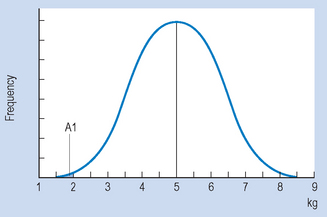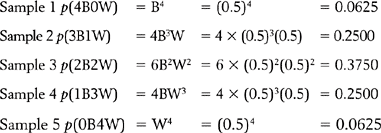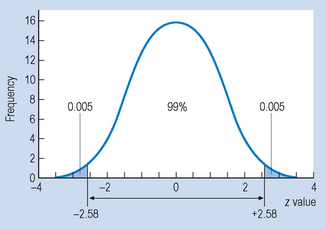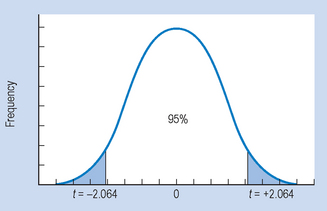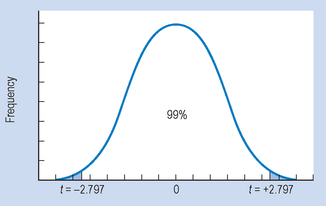Chapter Seventeen Probability and sampling distributions
Introduction
Sample statistics (such as  , s) are estimates of the actual population parameters μ, σ. Even where adequate sampling procedures are adopted, there is no guarantee that the sample statistics are the exact representations of the true parameters of the population from which the samples were drawn. Therefore, inferences from sample statistics to population parameters necessarily involve the possibility of sampling error. As stated in Chapter 3, sampling errors represent the discrepancy between sample statistics and true population parameters. Given that investigators usually have no knowledge of the true population parameters, inferential statistics are employed to estimate the probable sampling errors. While sampling error cannot be completely eliminated, its probable magnitude can be calculated using inferential statistics. In this way investigators are in a position to calculate the probability of being accurate in their estimations of the actual population parameters.
, s) are estimates of the actual population parameters μ, σ. Even where adequate sampling procedures are adopted, there is no guarantee that the sample statistics are the exact representations of the true parameters of the population from which the samples were drawn. Therefore, inferences from sample statistics to population parameters necessarily involve the possibility of sampling error. As stated in Chapter 3, sampling errors represent the discrepancy between sample statistics and true population parameters. Given that investigators usually have no knowledge of the true population parameters, inferential statistics are employed to estimate the probable sampling errors. While sampling error cannot be completely eliminated, its probable magnitude can be calculated using inferential statistics. In this way investigators are in a position to calculate the probability of being accurate in their estimations of the actual population parameters.
The aims of this chapter are to examine how probability theory is applied to generating sampling distributions and how sampling distributions are used for estimating population parameters. Sampling distributions can be used for specifying confidence intervals, as discussed in this chapter, as well as for testing hypotheses, as further discussed in Chapter 18.
Probability
The concept of probability is central to the understanding of inferential statistics. Probability is expressed as a proportion between 0 and 1, where 0 means an event is certain not to occur, and 1 means an event is certain to occur. Therefore if the probability (p) is 0.01 for an event then it is unlikely to occur (chance is 1 in a hundred). If p = 0.99 then the event is highly likely to occur (chance is 99 in a hundred). The probability of any event (say event A) occurring is given by the formula:
Sometimes the probability of an event can be calculated a priori (before the event) by reasoning alone. For example, we can predict that the probability of throwing a head (H) with a fair coin is:
Or, if we buy a lottery ticket in a draw where there are 100 000 tickets, the probability of winning first prize is:
This is true only if the lottery is fair, if all tickets have an equal chance of being drawn by random selection.
In some situations, there is no model which we can apply to calculate the occurrence of an event a priori. For instance, how can we calculate the probability of an individual dying of a specific condition? In such instances, we use previously obtained empirical evidence to calculate probabilities a posteriori (after the event).
For example, if it is known that the percentages (or proportions) for causes of death are distributed in a particular way, then the probability of a particular cause of death for a given individual can be predicted. Table 17.1 represents a set of hypothetical statistics for a community.
Table 17.1 Causes of death for persons over 65
| Cause of death | Percentage of deaths |
|---|---|
| Coronary heart disease | 50 |
| Cancer | 25 |
| Stroke | 10 |
| Accidents | 5 |
| Infections | 5 |
| Other causes | 5 |
Given the data in Table 17.1, we are in a position to calculate the probability of a selected individual over 65 dying of any of the specified causes. For example, the probability of a given individual dying of coronary heart disease is:
This approach ignores individual risk factors and assumes that the environmental conditions under which the data were obtained are still pertinent. However, the example illustrates the principle that once we have organized the data into a frequency distribution we can calculate the probability of selecting any of the tabulated values. This is true whether the variable was measured on a nominal, ordinal, interval or ratio scale. Here, we will examine how to calculate the probability of values for normally distributed, continuous variables.
We can use the normal curve model, as outlined in Chapter 15, to determine the proportion or percentage of cases up to, or between, any specified scores. In this instance, probability is defined as the proportion of the total area cut off by the specified scores under the normal curve. The greater the proportion, the higher the probability of selecting the specified values.
For example, say that on the basis of previous evidence we can specify the frequency distribution of neonates’ weight. Let us assume that the distribution is approximately normal, with the mean ( ) of 5.0 kg and a standard deviation (s) of 1.5. Now, say that we are interested in the probability of a randomly selected neonate having a birth weight of 2.0 kg or under. Figure 17.1 illustrates the above situation.
) of 5.0 kg and a standard deviation (s) of 1.5. Now, say that we are interested in the probability of a randomly selected neonate having a birth weight of 2.0 kg or under. Figure 17.1 illustrates the above situation.
The area A1 under the curve in Figure 17.1 corresponds to the probability of obtaining a score of 2 or under. Using the principles outlined in Chapter 15 to calculate proportions or areas under the normal curve, we first translate the raw score of 2 into a z score:
Now we look up the area under the normal curve corresponding to z = − 2 (Appendix A). Here we find that A1 is 0.0228. This area corresponds to a probability, and we can say that ‘The probability of a neonate having a birth weight of 2 kg or less is 0.0228’. Another way of stating this outcome is that the chances are approximately 2 in 100, or 2%, for a child having such a birth weight.
We can also use the normal curve model to calculate the probability of selecting scores between any given values of a normally distributed continuous variable. For example, if we are interested in the probability of birth weights being between 6 and 8 kg, then this can be represented on the normal curve (area A2 on Fig. 17.2). To determine this area, we proceed as outlined in Chapter 15. Let s = 1.5.
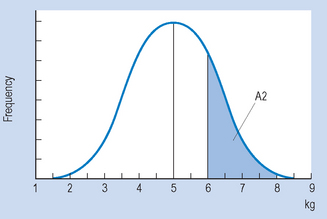
Figure 17.2 Frequency distribution of neonate birth weights. Area A2 corresponds to probability of weight being 6–8 kg.
Therefore: the area between z1 and  is 0.2486 (from Appendix A) and the area between z2 and
is 0.2486 (from Appendix A) and the area between z2 and  = 0.4772 (from Appendix A). Therefore, the required area A2 is:
= 0.4772 (from Appendix A). Therefore, the required area A2 is:
It can be concluded that the probability of a randomly selected child having a birth weight between 6 and 8 kg is p = 0.2286. Another way of saying this is that there is a chance of 23 in 100 or a 23% chance that the birth weight will be between 6 and 8 kg.
The above examples demonstrate that when the mean and standard deviation are known for a normally distributed continuous variable, this information can be applied to calculating the probability of events related to this distribution. Of course, probabilities can be calculated for other than normal data but this requires integral calculus which is beyond the scope of this text. In general, regardless of the shape or scaling of a distribution, scores which are common or ‘average’ are more likely to be selected than those which are atypical, being unusually high or low.
Sampling distributions
Probability theory can also be applied to calculate the probability of obtaining specific samples from populations.
Consider a container with a very large number of identically sized marbles. Imagine that there are two kinds of marbles present, black (B) and white (W), and that these colours are present in equal proportions, so that p (B) =p (W) = 0.5.
Given the above population, say that samples of marbles are drawn randomly and with replacement. (By ‘replacement’ we mean the samples are put back into the population, in order to maintain as a constant the proportion of B = W = 0.5.) If we draw samples of four (that is, n = 4) then the possible proportions of black and white marbles in the samples can be deduced a priori as shown in Figure 17.3.

Figure 17.3 Characteristics of possible samples of n = 4, drawn from a population of black and white marbles.
Ignoring the order in which marbles are chosen, Figure 17.3 demonstrates all the possible outcomes for the composition of samples of n = 4. It is logically possible to draw any of the samples shown. However, only one of the samples (2B, 2W), is representative of the true population parameter. The other samples would generate incorrect inferences concerning the state of the population. In general, if we know or assume (hypothesize) the true population parameters, we can generate distributions of the probability of obtaining samples of a given characteristic.
In this instance, when attempting to predict the probability of specific samples drawn from a population with two discrete elements, the binomial theorem can be applied. The expansion of the binomial expression, (P + Q)n, generates the probability of all the possible samples which can be drawn from a given population. The general equation for expanding the binomial expression is:
P is the probability of the first outcome, Q is the probability of the second outcome and n is the number of trials (or the sample size).
In this instance, P =proportion black (B) = 0.5; Q = proportion white (W) = 0.5; n = 4 (sample size). Therefore, substituting into the binomial expression:
Note that each part of the expansion stands for a probability of obtaining a specific sample. For the present case:
The calculated probabilities add up to 1, indicating that all the possible sample outcomes have been accounted for. However, the important issue here is not so much the mathematical details but the general principle being illustrated by the example. For a given sample size (n) we can employ a mathematical formula to calculate the probability of obtaining all the possible samples from a population with known parameters. The relationship between the possible samples and their probabilities can be graphed, as shown in Figure 17.4.
Taking the statistic ‘number of black marbles in the sample’, the graph in Figure 17.4 shows the probability of obtaining any of the outcomes. The distribution shown is called a ‘sampling distribution’. In general, a sampling distribution for a statistic indicates the probability of obtaining any of the possible values of a statistic.
Therefore, having obtained our sampling distribution we can see that some sample outcomes have low probability while others are more likely. Although there is a finite chance of obtaining a sample such as ‘all blacks’, the probability of this happening is rather small (p = 0.0625). Conversely, a sample of 2B2W, which is equal to the true population proportions, is far more probable (p = 0.375). Generating sampling distributions for calculating the probability of given sample statistics is a basic practice in inferential statistics. The sampling distributions enable researchers to infer (with a determined level of confidence) the true population parameters from the sample statistics.
Sampling distribution of the mean
The binomial theorem is appropriate for generating sampling distributions for discontinuous nominal scale data. However, when measurements are continuous, the mean and standard deviations are appropriate as sample statistics and are measured on interval or ratio scales. The sampling distribution of the mean represents the frequency distribution of sample means obtained from random samples drawn from the population. The sampling distribution of the mean enables the calculation of the probability of obtaining any given sample mean ( ). This is essential for testing hypotheses about sample means (Ch. 18).
). This is essential for testing hypotheses about sample means (Ch. 18).
In order to generate the sampling distribution of the mean, we use a mathematical theorem called the central limit theorem. This theorem provides a set of rules which relate the parameters (μ, σ) of the population from which samples are drawn to the distribution of sample means ( ).
).
The central limit theorem states that if random samples of a fixed n are drawn from any population, as n becomes large the distribution of sample means approaches a normal distribution, with the mean of the sample means (
 or μ
or μ ) being equal to the population mean (μ) and the standard error of estimate (s
) being equal to the population mean (μ) and the standard error of estimate (s or σ
or σ ) being equal to σ/
) being equal to σ/ . The standard error of the estimate is the standard deviation of the distribution of sample means.
. The standard error of the estimate is the standard deviation of the distribution of sample means.
Let us follow the above step by step.
 , is a number. The sampling distribution of the mean is a frequency distribution representing the large number of sample means.
, is a number. The sampling distribution of the mean is a frequency distribution representing the large number of sample means.
 or μ
or μ ) and standard deviation (s
) and standard deviation (s or σ
or σ ) of a large number of sample means.
) of a large number of sample means. or
or 
 ) is the mean of the distribution of sample means.
) is the mean of the distribution of sample means. 
 and μ
and μ are equal to μ, the population mean.
are equal to μ, the population mean. or σ
or σ ) is the standard deviation of the frequency distribution of sample means drawn from a population. The magnitude of s
) is the standard deviation of the frequency distribution of sample means drawn from a population. The magnitude of s or σ
or σ is equal to σ/
is equal to σ/ , the population standard deviation divided by the square root of the sample size.
, the population standard deviation divided by the square root of the sample size. and σ
and σ are used in reference to a sampling distribution based on all the possible samples drawn from a population (a population of samples, would you believe?), while
are used in reference to a sampling distribution based on all the possible samples drawn from a population (a population of samples, would you believe?), while  and s
and s are used when the sampling distribution is based on a ‘sample’ of samples.
are used when the sampling distribution is based on a ‘sample’ of samples.Let us have a look at an example. Assume for a hypothetical test of motor function that μ= 50 and σ= 10. What is the probability of drawing a random sample from this population with  = 52 or greater (i.e.
= 52 or greater (i.e.  ≥ 52) given that n = 100? The central limit theorem predicts that when we draw samples of n = 100 from the above population, the sampling distribution of the means will be as follows:
≥ 52) given that n = 100? The central limit theorem predicts that when we draw samples of n = 100 from the above population, the sampling distribution of the means will be as follows:
(We can show this as in Fig. 17.5.)
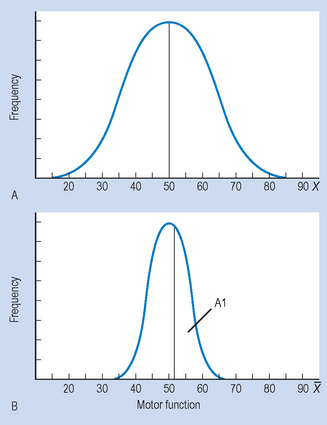
Figure 17.5 Relationship between original population and sampling distribution of the mean, where μ= 50 and σ= 10; (A) original population, (B) sampling distribution of the mean.
Previously, we saw how we can use normal frequency distributions for estimating probabilities. Using the same principles as in Chapter 15, we can calculate the z score corresponding to  = 52, and look up Appendix A to find out the area representing the probability in question:
= 52, and look up Appendix A to find out the area representing the probability in question:
That is,  = 52 is two standard error units above μ
= 52 is two standard error units above μ , the population mean for the sample means.
, the population mean for the sample means.
You may have noticed that the distribution of  is far less dispersed than X (i.e. the raw scores), as σ
is far less dispersed than X (i.e. the raw scores), as σ = 1 and σ= 10.
= 1 and σ= 10.
Using Appendix A for establishing the probability, we find that the area representing p ( ≥ 52), that is, area A1 in Figure 17.5B, is:
≥ 52), that is, area A1 in Figure 17.5B, is:
Therefore the probability of drawing a sample of  ≥ 52 is 0.0228. We will apply this notion to hypothesis testing in Chapter 18, but you might have noticed that it is a rather low probability. That is, it is unlikely (p = 0.0228) randomly to draw a sample with
≥ 52 is 0.0228. We will apply this notion to hypothesis testing in Chapter 18, but you might have noticed that it is a rather low probability. That is, it is unlikely (p = 0.0228) randomly to draw a sample with  ≥ 52 where n = 100 and μ= 50.
≥ 52 where n = 100 and μ= 50.
Application of the central limit theorem to calculating confidence intervals
Let us assume that you are asked to estimate the weight of a newborn baby. If you are experienced in working with neonates, you should be able to make a reasonable guess. You might say ‘The baby is 6 kg’. Someone might ask ‘How certain are you that the baby is exactly 6 kg?’ You might then say ‘Well, the baby might not be exactly 6 kg, but I’m very confident that it weighs somewhere between 5.5 and 6.5 kg’. This statement expresses a confidence interval – a range of values which probably include the true value. Of course, the more certain or confident you want to be of including the true value, the bigger the range of values you might give: you are unlikely to be wrong if you guess that the baby weighs between 4 and 8 kg.
Confidence intervals can be calculated for a large range of statistics such as proportions, ratios or correlation coefficients. In this chapter we will look at confidence intervals for single samples as an illustration for using confidence intervals.
We have seen previously that if we know the population parameters we can estimate the probability of selecting from that population a sample mean of a given magnitude. Conversely, if we know the sample mean we can estimate the population parameters from which the sample might have come, at a given level of probability. Let us take an example to illustrate this point.
A researcher is interested in the systolic blood pressure (BP) levels of smokers of more than 10 cigarettes per day. She takes a random sample of 100 10+ smokers in her district and finds that the mean BP = 148 mmHg for the sample, with a standard deviation of s = 10.
She wants to generalize to the population of smokers of more than 10 cigarettes per day in their district. The best estimate of μ (the population parameter) is 148, but it is possible that, because of sampling error, 148 is not the exact population parameter. However she can calculate a confidence interval (a range of blood pressures that will include the true population mean at a given level of probability). A confidence interval is a range of scores which includes the true population parameter at a specified level of probability. The precise probability is decided by the researcher and indicates how certain she can be that the population mean is actually within the calculated range. Common confidence intervals used in statistics are 95% confidence intervals, which offer a probability of p = 0.95 for including the true population mean, and 99% confidence intervals, which include the true population mean at a probability of p = 0.99.
Calculating the confidence interval requires the use of the following formula:
where  is the sample mean; z is the z score obtained from the normal curve table such that it cuts off the area of the normal curve corresponding to the required probability; s
is the sample mean; z is the z score obtained from the normal curve table such that it cuts off the area of the normal curve corresponding to the required probability; s is the sample standard error, which is equal to the sample standard deviation divided by √n, that is, s
is the sample standard error, which is equal to the sample standard deviation divided by √n, that is, s = s/√n.
= s/√n.
Let us turn to the previous example to illustrate the use of the above equation. Here  = 148, and s
= 148, and s = 51/√100. Assume that we want to calculate a 95% confidence interval. We are looking for a pair of z scores which have 95% of the standard normal curve between them. In this case, 1.96 is the value for z which cuts off 95% of a normal distribution. That is, we looked up the value of z corresponding to an area (probability) of 0.4750, since the 0.05 has to be divided among the two tails of the distribution, giving 0.025 at either end. Substituting into the equation above we have:
= 51/√100. Assume that we want to calculate a 95% confidence interval. We are looking for a pair of z scores which have 95% of the standard normal curve between them. In this case, 1.96 is the value for z which cuts off 95% of a normal distribution. That is, we looked up the value of z corresponding to an area (probability) of 0.4750, since the 0.05 has to be divided among the two tails of the distribution, giving 0.025 at either end. Substituting into the equation above we have:
That is, the investigator is 95% confident that the true population mean, the true mean BP of smokers, lies between 146.04 (lower limit) and 149.96 (upper limit). There is only a 5% or 0.05 probability that it lies outside this range. If we chose a 99% confidence interval, then using the formula as above, we have:
Here, 2.58 is the value of z which cuts off 99% of a normal distribution (Fig. 17.6). That is, the investigator is 99% confident that the true population mean lies somewhere between 145.42 and 150.58. Clearly, the 99% interval is wider than the 95% interval; after all, here the probability of including the true mean is greater than for the 95% interval. Conventionally, health sciences publications report 95% confidence intervals.
Confidence intervals where n is small: the t distribution
It was previously stated that: ‘as n becomes large, the distribution of sample means approaches a normal distribution’ (central limit theorem). The questions left to explain are:
It has been shown by mathematicians that the sample size, n, for which the sampling distribution of the mean can be considered an approximation of a normal distribution is n ≥ 30. That is, if n is 30 or more, we can use the standard normal curve to describe the sampling distribution of the mean. However, when n < 30, the sampling distribution of the mean is a rather rough approximation to the normal distribution. Instead of using the normal distribution, we use the t distribution, which takes into account the variability of the shape of the sampling distribution due to low n.
The t distributions (Fig. 17.7) are a family of curves representing the sampling distributions of means drawn from a population when sample size, n, is small (n < 30). A ‘family of curves’ means that the shape of the t distribution varies with sample size. It has been found that the distribution is determined by the degrees of freedom of the statistic.
The degrees of freedom (df) for a statistic represents the number of scores which are free to vary when calculating the statistic. Since the statistic we are calculating in this case is the mean, all but one of the scores could vary. That is, if you were inventing scores in a sample with a known mean, you would have a free hand until the very last score. There df is equal to n − 1 (the sample size minus one). Each row of figures shown in Appendix B represents the critical values of t for a given distribution.
The t distribution, just as the z distribution, can be used to approximate the probability of drawing sample means of a given magnitude from a population; t can also be used for calculating confidence intervals. Let us re-examine the example relating to the blood pressure of smokers presented earlier. Let us assume that n = 25, with the other statistics remaining the same:  = 148, s = 10. The general formula for calculating the confidence intervals for small samples is:
= 148, s = 10. The general formula for calculating the confidence intervals for small samples is:
You will note the similarity to the equation on page 199; here t replaces z. If we want to show the 95% confidence interval, then we use the same logic as for z distributions (Fig. 17.8).
To look up the t values from the tables (Appendix B) consider (i) direction, (ii) probabilities and (iii) degrees of freedom.
We are looking at a ‘non-directional’ or ‘two-tail’ probability in the sense that the t values cut off 95% of the area of the t curve between them, leaving 5% distributed at the two tails of the t distribution: p = 0.05; df = 25 − 1 = 24. Therefore t = 2.064 (from Appendix B). Substituting into the equation for calculating confidence intervals:
Consider the width of the confidence interval defined as the distance between the upper and lower limits. Note that this is a wider interval than that which was obtained when n was 100. As sample size, n, becomes smaller, our confidence interval becomes wider, reflecting a greater probability of sampling error.
To calculate the 99% confidence interval (Fig. 17.9) we need to look up p = 0.01, nondirectional, df = 24 in Appendix B to obtain the critical value of t, which is 2.797.
We can see that, when n = 25, the 99% confidence interval is wider than for n = 100. That is, the bigger our sample size, the narrower (more precise) our estimate of the range of values (which includes the true population parameter) becomes when our sample size is large.
Summary
It was argued in this chapter that, even with randomly selected samples, the possibility of sampling error must be taken into account when making inferences from sample statistics to population parameters. It was shown that probability theory can be applied to generating sampling distributions, which express the probability of obtaining a given sample from a population. With discontinuous, nominal data the binomial theorem provides an adequate mathematical distribution for estimating the probability of obtaining possible samples. However, with continuous data, the central limit theorem is applied to generate the sampling distributions of the mean. The standard distribution of the mean enables the calculation of the probability-specified sample mean(s) by random selection. The sampling error of the mean (s or σ
or σ ), which expresses statistically the range of the sampling error, depends inversely on the sample size, such that the larger the n, the smaller the s
), which expresses statistically the range of the sampling error, depends inversely on the sample size, such that the larger the n, the smaller the s or σ
or σ .
.
One of the applications of sampling distributions is for calculating confidence intervals for continuous data. Confidence intervals represent a range of scores which specify, from sample data, the probability of capturing the true population parameters.
Health researchers usually report 95% confidence intervals. When sample sizes are small (n < 30), the t distribution is appropriate for representing the sampling distribution of the mean. With large sample sizes, the two distributions merge together. As the next chapter will demonstrate, sampling distributions are essential for testing hypotheses, a procedure which uses inferential statistics to calculate the level of probability at which sample statistics support the predictions of hypotheses.
Self-assessment
Explain the meaning of the following terms:
True or false
Multiple choice
| Weight of neonates (g) | Numbers (n) | Percentage of neonates surviving |
|---|---|---|
| 0–499 | 25 | 40 |
| 500–999 | 50 | 60 |
| 1000–1499 | 75 | 80 |
| 1500–1999 | 150 | 90 |
| 2000–2499 | 250 | 95 |
| 2500 | 450 | 98 |




